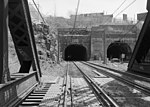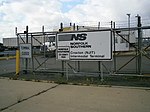Bergen Arches
Erie RailroadErie Railroad tunnelsGeography of Hudson County, New JerseyHistoric American Engineering Record in New JerseyHistoric districts in Hudson County, New Jersey ... and 5 more
Landforms of Hudson County, New JerseyRailroad tunnels in New JerseyTransportation in Jersey City, New JerseyTunnels in Hudson County, New JerseyUse mdy dates from May 2018

Bergen Arches is an abandoned railroad right of way through Bergen Hill (the lower New Jersey Palisades) in Jersey City, New Jersey.
Excerpt from the Wikipedia article Bergen Arches (License: CC BY-SA 3.0, Authors, Images).Bergen Arches
Saint Pauls Avenue, Jersey City
Geographical coordinates (GPS) Address Nearby Places Show on map
Geographical coordinates (GPS)
| Latitude | Longitude |
|---|---|
| N 40.7369 ° | E -74.0594 ° |
Address
201 St Pauls
Saint Pauls Avenue 201
07306 Jersey City
New Jersey, United States
Open on Google Maps










